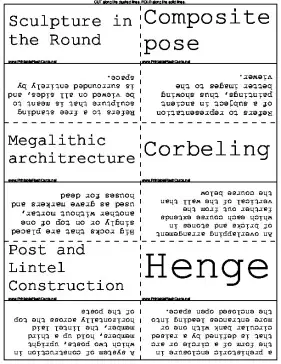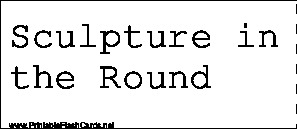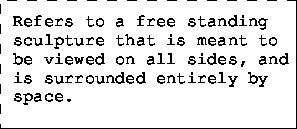

Learn about art and art history in these painting and sculpture flash cards
There are 44 flash cards in this set (8 pages to print.)
To use:
1. Print out the cards.
2. Cut along the dashed lines.
3. Fold along the solid lines.
Sample flash cards in this set:




| Questions | Answers |
|---|---|
| Sculpture in the Round | Refers to a free standing sculpture that is meant to be viewed on all sides, and is surrounded entirely by space. |
| Composite pose | Refers to representation of a subject in ancient paintings, thus showing better images to the viewer. |
| Megalithic architrecture | Big rocks that are placed singly or on top of one another without mortar, used as grave markers and houses for dead |
| Corbeling | An overlapping arrangement of bricks and stones in which each course extends farther out from the vertical of the wall than the course below |
| Post and Lintel Construction | A system of construction in which two posts, upright members, hold up a third member, the lintel laid horizontally across the top of the posts |
| Henge | a prehistoric enclosure in the form of a circle or arc that is defined by a raised circular bank with one or more entrances leading into the enclosed open space. |
| Hieratic Scale | use of different size for significant or holy figures and those of the everyday world to indicate importance, larger figure=more important |
| Relief Sculpture (High and Low) | a 3D image or design whose flat background surface is carved away to a certain depth, setting off the figure; called high or low relief depending upon the extent or projection of the image from the background. |
| Register | a device used in systems of spatial definition; in painting a register indicates the use of differing groundlines to differentiate layers of space within an image |
| Provenance | means to come from, refers to where the art actually came from, the chronology and history of the piece |
| Votive | an image created as a devotional offering to a god or other deity |
| Ziggurats | in Mesopotamia, a tall stepped tower of earthen materials, often supporting a shrine |
| Stele | a stone slab placed vertically and decorated with inscriptions or reliefs used as a grave maker or a memorial |
| Cuneiform | one of the earliest forms of writing, distinguished by its wedge shaped marks on clay tables |
| Mastaba | a flat topped one story structure with slanted walls over an ancient Egyptian underground tomb |
| Necropolis | a large cemetery or burial area; literally a city of the dead. |
| ka | the name given by ancient Egyptians to the human life source or spirit |
| Idealization | a process in art through which artists strive to make their forms and figures attain perfection based on pervading cultural values |
| Canon or Proportions | a set of ideal mathematical values in art based on measurements of the human body |
| Naturalism | a style of depiction that seeks to imitate the appearance of nature |
| Clerestory | the topmost zone of a wall with windows in a basilica extending above the aisle roofs; provides direct light into the central interior space |
| Capital | the upper part of a column or pier that supports the entableture |
| sunken relief | Relief when the image is carved below the original surface of the background; which is not cut away |
| Cycladic | works of art from the Cycladic islands. many figurines were buried in graves |
| Fresco | a painting technique in which water based pigments are applied to surface of wet plaster; the color is absorbed by the plaster, becoming part of the wall. |
| Stylobate | the top step of the crepidoma, the platform upon which the superstructure of the building is erected |
| Column | Pillars in architecture that through compression holds the weight of a structure |
| Entablature (architrave, frieze, cornice) | refers to the superstructure of moldings and bands which lie horizontally above columns |
| Triglyph | an ornament in a Doric frieze |
| Metope | rectangular architectural element that fills the space between two triglyphs in a Doric frieze |
| Pediment | triangular space that forms the gable of a roof |
| Cella | inner chamber of a temple in a classical architecture |
| Peristyle | columned porch or open colonnade in a building surround a court |
| Entasis | a slight swelling of the shaft of a Greek column; the optical illusion of entasis makes the columns appear from afar to be straight |
| Doric Order | fluted columns with rounded molding at the top and no base |
| Ionic Order | fluted columns and capitals with spiral scroll shaped ornaments |
| Corinithian Order | slender column with ornate capital |
| Archaic Smile | the archaic smile is the smile that characteristically appears on the faces of Greek statues during the Archaic period |
| Black Figure Painting | In early Greek pottery, the silhouetting of dark figures against a light background of natural, reddish clay, with linear details incised through the silhouettes |
| Red-Figure Painting | in later Greek pottery, the silhouetting of red figures against a black background, with painted linear details; the reverse of the black figure painting |
| Contrapposto | the disposition of the human figure in which one part is turned in opposition to another part, sometimes called weight shift because the weight of the body tends to be thrown to one foot. |
| Lost-Wax Casting | late Cycladic gold ibex sculpture about 10 cm long with lost was cast feet and head |
| Caryatid | a female figure that functions as a supporting column |
| Hellenistic Period | period of ancient Greek and Mediterranean history between the death of Alexander the Great and the annexation of the classical Greek heartlands. |